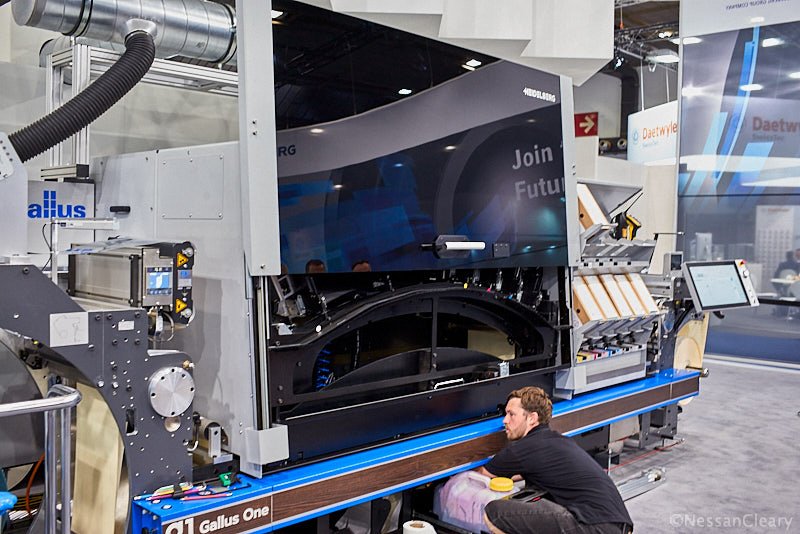Dr Ludwin Monz, who has been CEO of Heidelberg since April 2022, has announced his intention to leave the company at the end of June. He will be replaced by Jürgen Otto (59). But what does this mean for Heidelberg’s future?
The decision has obviously caught Heidelberg by surprise, with a statement from Dr Martin Sonnenschein, chairman of Heidelberg’s Supervisory Board, who commented, “We very much regret Dr Ludwin Monz’s decision to leave Heidelberg. He has decisively advanced our company strategically and operationally and thus strengthened our foundation in a difficult market environment. With Jürgen Otto, we are gaining a proven leader. With his experience and network, we will continue to consistently prepare Heidelberg for the future, increase profitability and further strengthen our significant technological expertise in the printing and packaging industry and beyond.”
Otto has built a reputation in recent years for helping companies to reorganise. According to his LinkedIn profile, his recent jobs have all been short tenures where he was brought in to restructure the company, and in particular its management. His background is in the automotive industry, where he spent 27 years – the last 12 as CEO – working for the Brose Group, which specialises in vehicle interiors. That was followed by 15 months as CEO helping to restructure the Draxlmaier Group and 19 months as CEO of Borgers Group, which was acquired by Autoneum shortly after he left.
All of these companies are in the automotive world but in January 2023 he moved into the fashion business as CEO of S.Oliver group, where he was credited with helping to turn the company around after large losses in 2022, and with reshaping its strategic realignment. Interestingly, the press release from S.Oliver announcing his departure also stated that he “will remain associated with the company in an advisory capacity and will support the owner and management in the implementation of the Group’s digital and vertical projects that have already been launched” which not surprisingly is not mentioned in any of Heidelberg’s communications.

Heidelberg’s press release on its change of management included a statement from Jürgen Otto, “Heidelberg is an icon of German industry with product quality and service expertise that is appreciated worldwide.” It’s worth noting that Monz expressed remarkably similar sentiments when he joined the company, “For me, Heidelberger Druckmaschinen is a flagship of German mechanical engineering.” So it’s at least reassuring to see that there is some continuity from whoever is writing the CEO’s quotes.
More worryingly, neither Monz or Otto appear to view Heidelberg as a press manufacturer. In 2022 Monz told shareholders that the company would have to expand beyond printing. Yet at last year’s Interpack, he told journalists in a press conference that it was difficult to find other markets that would have more than a short term growth.
Monz used a recent pre-Drupa press briefing to reiterate that Heidelberg is pursuing a two-track strategy, explaining, “We will remain in printing. That’s what Heidelberg stands for and it remains our future. However, we also explore new areas like the charging for electric vehicles.”
There are a number of difficulties with this strategy. Firstly, it suggests a lack of confidence in the core printing business, with Heidelberg having to look elsewhere for growth. Yet, other vendors such as Koenig and Bauer or Bobst don’t seem to have the same issues.
There is some sense in diversifying into another business area, both to find extra growth and to protect the company from the inevitable vagaries of the market. But there is also a risk that the company will lose focus. And, of course, as Monz noted, it is difficult to find another business that will be complementary to Heidelberg and have good long term prospects.
Heidelberg was able to grow its Amperfied EV charging business from its knowledge of electronics and manufacturing. It also benefited from German government grants that aimed to encourage the take-up of electric vehicles. But there’s little evidence that Heidelberg has incubated much else in the way of start-ups that could grow into a bigger business, as Durst, for example, has done with its Kraftwerk project.
Another alternative would be to buy a selection of smaller companies and put them together to create a business that’s bigger than the sum of its parts. That would require time and a creative vision, two qualities that Heidelberg seems to be short of. Nonetheless, this is what Fujifilm did, buying Dimatix for printheads, plus Sericol and Avecia for inkjet inks, to create a strong base in inkjet printing. It’s also the route taken by Hybrid Software, buying Global Graphics, Meteor Inkjet, Color-Logic and iC3D to put together a comprehensive workflow solution.
Nor is there any sign of any big new direction from within Heidelberg’s core printing business since the demise of the B1 inkjet PrimeFire press. Monz says that the PrimeFire was mainly aimed at the packaging market, adding, “This was a powerful concept however the market was not ready for it and it was too expensive in terms of cost per printed sheet.”
Instead there is much talk of digitization, but this just means increasing automation, in some cases aided by artificial intelligence. Since all the competitors are doing the same there’s little room for differentiation.
For Drupa, Heidelberg will show the latest Peak Performance generation of its Speedmaster XL106 B1 offset press, which can reach speeds of up to 21,000sph. Markus Leichtle, senior manager for industrial packaging, says, “It’s suitable for different market segments and different budgets. We know that our customers have different business models and produce different products so it’s highly configurable.” He says that it’s also able to handle both very thin and very thick materials, from 0.03 to 1mm.
It boasts 30% faster makeready times which Leichtle says is down to increased intelligent automation, adding, “This is particularly useful for pharma because they are using short runs and a lot of job changes.” It also benefits from a new drier that will save up to 30% of drying energy. Leichtle notes, “Speeding up a press improves its energy performance.”
Heidelberg will also show a single print unit from the Boardmaster flexo press that it introduced at last year’s Interpack. This press has generally been well-received, and together with the new XL106 means that Heidelberg has a solid offer to the folding carton packaging market for both flexo and offset.

Elsewhere at Drupa we will see a resurgence in toner-based production printers, continuing growth in mid-range inkjet presses for commercial printing, a dramatic leap in digital printing for paper-based packaging and the first shoots of inkjet presses for flexible film packaging. But, barring any last minute surprises, we won’t see any of this on the Heidelberg stand. Monz went on to say that Heidelberg believes in digital but that the biggest market for digital technology was in commercial printing. Naturally he glossed over the weakness in Heidelberg’s position – that it’s reliant on rebadging Ricoh dry toner production printers for commercial digital print. Instead he simply stated that Heidelberg was focused on offset for this Drupa.
This contrasts with Heidelberg’s annual report for last year, which noted, “Print shops can also be expected to increasingly adapt to the ‘Amazon effect’ with the same day or next day delivery of goods and service becoming standard. This means the transition from conventional to digital print is continuing as time-to-market and quick turnaround times become increasingly important.”
Speaking at the pre-Drupa briefing, Monz said. “I’m really convinced that the printing market will be good.” This of course is exactly what you would say to a room full of print industry journalists ahead of a large printing show. However, he already knew at that time that he would be leaving the company, and presumably the industry.
There are many questions facing Heidelberg over its plans for the future and the extent to which it still has a viable future. Ironically the company’s short term prospects look better than they have done in a long time, with healthy profits and a reasonable incoming order backlog. But its long term future looks less certain because the last few years have all been about re-engineering, both its finances and its technologies. The company has ruthlessly cut every project that wasn’t making money, which has helped it to become profitable for now.
Most recently this has resulted in the liquidation of the Zaikio business, which Heidelberg set up after acquiring Crispy Mountain and its Keyline cloud-based print MIS in 2019. Zaikio went on to develop an interesting open platform workflow concept. Heidelberg clearly hoped this would develop into a standalone business since it placed Zaikio in its Other Solutions division alongside the Amperfied EV charging business rather than as part of the Print Solutions division. For now Heidelberg has said that it is still negotiating how to liquidate the company so we won’t get a fuller picture until the next set of financial results in June. But there are a number of elements that Heidelberg will want to retain. Some of the Prinect services rely on the authentication solution provided by Zaikio and there are also a number of customers using the Keyline software.
Heidelberg has been able to redevelop some of its existing technologies to pick up some growth from the packaging market though it lacks a full portfolio of presses and converting equipment. More worryingly, despite many statements on the importance of digital printing for the future, Heidelberg does not have any in-house digital technology except the Gallus One label press. So it’s difficult to see where any future growth will come from for Heidelberg within the printing industry.

We might reasonably expect that the company would use a flagship event like Drupa to answer those questions but with Monz leaving this opportunity is lost. Instead, the timing has more to do with finance, with Monz having chosen to sign off just after Heidelberg publishes its full year results for the 2023/2024 year on 11 June, leaving Otto to face the Annual General Meeting on 25 July 2024.
The most recent figures, for the first three quarters of this financial year, show sales of €1.67 billion, which is less than the €1.73 billion from the same period in the previous year, but Heidelberg says that the figures match when adjusted for exchange rates. The operating result or Earnings Before Interest, Taxes, Depreciation and Amortisation, improved from €125 million to €135 million, with the margin up from 7.2% to 8%. However, the net result fell from €54 million to €34 million, which Heidelberg says is down to “higher tax expenditure, increased pension-related interest costs, and the lack of positive special items.”
I have written previously that I think that it’s deeply concerning that a company the size of Heidelberg should rely on just two board members – the CEO and CFO – for its day to day running. Fortunately a quick read through of the press releases from Otto’s previous companies suggests that he favours identifying the most capable of the current management team and promoting a selection of them to the board to eventually succeed him. In this vein, Heidelberg has said that Dr David Schmedding (47) will join the board, which is a start. He was previously Heidelberg’s head of sales and will now be the chief sales and service officer.
And then there is the chief financial officer, Tania von der Goltz. Monz spent 25 years working for the Zeiss group and was chairman of Carl Zeiss Meditec before joining Heidelberg in April 2022. At that time, Marcus Wassenberg, who was CFO, had his contract extended until 2027. But just a few months later, in November 2022 Heidelberg announced that von der Goltz would replace him as CFO from I January 2023. She has spent most of her career so far in the medical services industry, working for Fresenius Medical Care. In 2018 she picked up a side gig as a member of the supervisory board at Carl Zeiss Meditec, where she met Monz. So with Monz now leaving Heidelberg I think it’s reasonable to ask how long before Heidelberg is also looking for a CFO?
Hopefully Heidelberg will address some of these issues at Drupa. In the meantime, you can find further details on the company from heidelberg.com.
First published on 30th April 2024 on the Printing and Manufacturing Journal www.nessancleary.co.uk. Reprinted by permission.
















